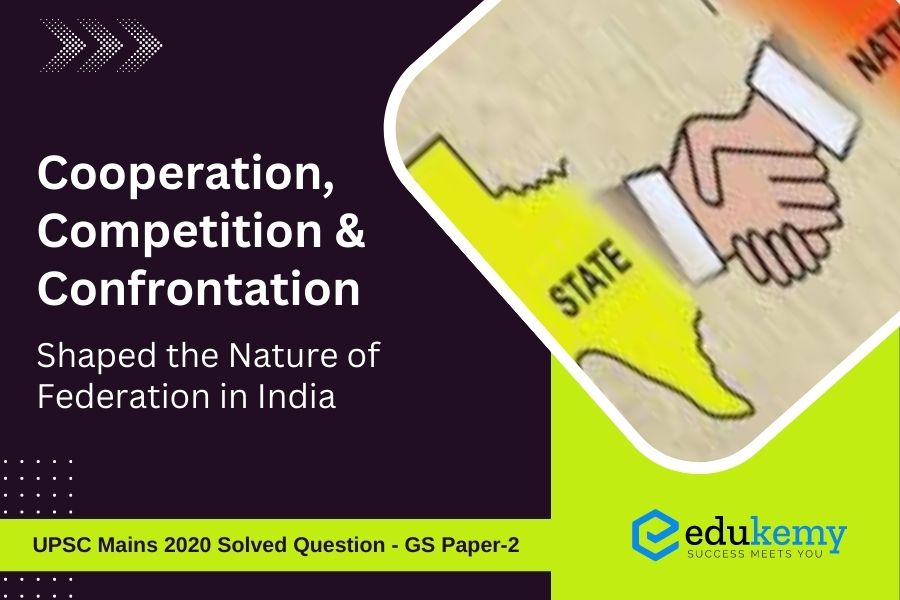The nature of the federation in India has been profoundly shaped by a delicate interplay of cooperation, competition, and confrontation. Since its independence in 1947, India has embraced a federal structure that seeks to balance the autonomy of its diverse states with a strong central authority. Cooperation is evident in the collaborative efforts between the central and state governments to address national challenges, foster economic development, and promote social welfare. However, competition arises as states vie for resources, recognition, and influence, leading to healthy democratic competition that fuels progress. Confrontation has emerged at times when there are disagreements over jurisdiction, resource allocation, and political ideologies, challenging the fabric of federalism. The intricate dance between these three elements has contributed to the dynamic and evolving nature of the Indian federation, reflecting the complex socio-political landscape of a nation marked by diversity and unity.
UPSC Mains General Studies Paper – 2 Mains 2020
Functions and Responsibilities of the Union and the States
Issues and Challenges Pertaining to the Federal Structure
UPSC Mains Civil Services IAS Exam Question Paper – 2020
Contents
- 1 Structure of the Question
- 2 Answer
- 3 Conclusion
- 4 Frequently Asked Questions (FAQs)
- 4.1 Q: How has cooperation played a role in shaping the nature of the federation in India?
- 4.2 Q: In what ways has competition impacted the dynamics of the Indian federation?
- 4.3 Q: How does confrontation contribute to the evolution of the Indian federation?
- 4.4 Q: To what extent has cooperative federalism been successful in India?
- 4.5 Q: How do historical events and socio-political factors influence the interplay between cooperation, competition, and confrontation in the Indian federation?
- 5 In case you still have your doubts, contact us on 9811333901.
Structure of the Question
- In Introduction,
- Define the concept of Federation and highlight Indian Federalism.
- In Body,
- Discuss the following terms in accordance with Federation of India with recent examples:
- Cooperation
- Competition
- Confrontation
- Discuss how cooperation, competition, and confrontation have shaped the Indian Federation.
- Conclude with the suggestive measure to reduce the confrontations among federal units.
Answer
Introduction
A federal government is one in which powers are divided between the national government and the regional governments by the Constitution itself. Indian federalism has a strong unitary bias, but due to unique socio-economic and political conditions, it has evolved to assume the various features of cooperative, competitive, and confrontational federalism.
Cooperative Federalism
Cooperative federalism comprises the federal government and state governments cooperating together during the nation’s overall development. The Centre and the states do have horizontal engagement in cooperative federalism, where they “cooperate” in the larger public interest. Cooperative federalism is a top-down approach, whereby the government provides the policy framework and inputs, but still, the states are responsible for the execution. The Indian constitution has cooperative federalism as part of its basic structure.
- E.g.- GST, NAM, land reforms, model APMCs act, 73rd and 74th CAA 1992, Centre-State Investment Agreement (CSIA), and the 14th Finance Commission’s 42 % devolution.
Competitive Federalism
It envisages competition between the states. When India opened its doors to globalization, there was greater competition for limited resources among the states. As a result, the states are now in a state of imbalance and inequity.
Competitive federalism has recently proven to be an effective technique for boosting individual states’ economic development. The union and the states are not required by the constitution to work together on the issues listed in Schedule VII of the Constitution. Executives make the decision. The Indian constitution does not include competitive federalism in its basic structure.
- E.g.– “Vibrant Gujarat”, “Resurgent Rajasthan” and various indexes evolved by NITI Aayog. The SDG India Index, Aspirational Districts Programme, Swachh Bharat Ranking, and Ease of Doing Business Ranking incorporate a sense of competition amongst the states for funds from the central government.
Confrontational Federalism:
It is a result of the central government transgressing into the powers of the state government. The unilateral revocation of the special status conferred on Jammu and Kashmir (J&K) under Article 370 of the Constitution has been criticized by many experts as against the spirit of federalism. Many constitutional experts have criticized the central government’s decision to use a concurrent List to make laws on state-list subjects.
- E.g.– The role of the governor as an agent of the central government (in Maharashtra & Karnataka) whereby governors act in a partisan way, generally against the state government whose views are not in concurrence with the party in power at the union level.
Way Forward
- Cooperative and competitive federalism is India’s future. Competitive federalism generates the dynamism that is needed.
- To balance competitive federalism, we need cooperative federalism.
- To foster Indian internal unity, the constitution needed to catch up with economics and “favor integration before preserving sovereignty.”
- Reactivation of the Centre-State Council: According to Article 263, this council is responsible for investigating and advising on disputes, discussing topics that affect all states, and making proposals for improved policy coordination.
- On issues like international treaties, WTO obligations, or the environment an institutional mechanism must be evolved where important decisions are appropriately discussed with states.
Conclusion
In SR Bommai vs Union of India (1994), the Supreme Court held federalism a part of the basic structure of the Constitution. However, due to the strong unitary bias and particularly the way it has evolved over the years, many constitutional experts describe Indian federalism as, a “federation without federalism”, “a Union of Unequal States” or “Quasi-Federal In Nature”.
Frequently Asked Questions (FAQs)
Q: How has cooperation played a role in shaping the nature of the federation in India?
Cooperation has been a fundamental aspect in the formation and sustenance of the Indian federation. How have collaborative efforts among states and the central government influenced the development of federal structures, policies, and decision-making processes?
Q: In what ways has competition impacted the dynamics of the Indian federation?
Explore the competitive aspects among states in terms of economic development, resource allocation, and political influence. How has healthy competition contributed to the overall progress of the country, and conversely, how has it presented challenges to federal harmony?
Q: How does confrontation contribute to the evolution of the Indian federation?
Address the instances of confrontation between the center and states, and among states themselves. How have conflicts shaped constitutional interpretations, intergovernmental relations, and the balance of power within the federation?
Q: To what extent has cooperative federalism been successful in India?
Evaluate the effectiveness of cooperative federalism in achieving common goals and addressing shared challenges. What examples can be cited to illustrate instances where states and the central government have successfully collaborated for the greater good?
Q: How do historical events and socio-political factors influence the interplay between cooperation, competition, and confrontation in the Indian federation?
Analyze the historical context and sociopolitical factors that have influenced the nature of cooperation, competition, and confrontation within the Indian federation. How have these factors contributed to the evolution of federal structures and the distribution of powers in the country?
In case you still have your doubts, contact us on 9811333901.
For UPSC Prelims Resources, Click here
For Daily Updates and Study Material:
Join our Telegram Channel – Edukemy for IAS
- 1. Learn through Videos – here
- 2. Be Exam Ready by Practicing Daily MCQs – here
- 3. Daily Newsletter – Get all your Current Affairs Covered – here
- 4. Mains Answer Writing Practice – here



